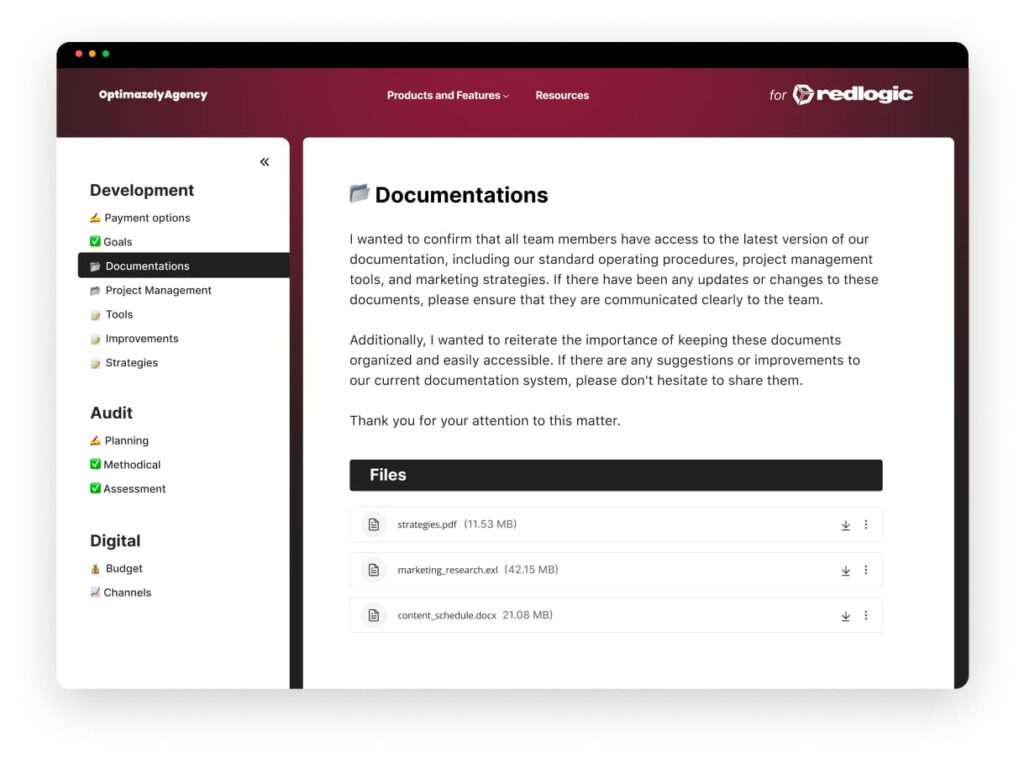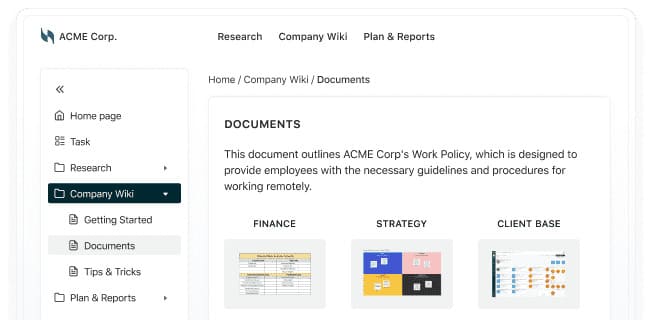
14 Top Client Collaboration Software (Tested and Reviewed in 2025)
- 10 Min read
Imagine any business and you will have to think about documents that accompany every step of that business’s life. Whether it is a retailer, a manufacturer or a service provider, any business is bound to have data that is accumulated, analyzed, stored and shared in the shape of documents. Today’s data-driven world has almost left paper-heavy documentation behind, so documents are no longer hard copies kept in thick folders or filing cabinets. Instead, we have seen the advent of digital documents, which have allowed us to go paperless and become a lot more dynamic. Text files and spreadsheets, presentations and reports – all these are now electronic documents that we store and share as computer files.
Digital documents offer numerous benefits: they save money on paper and printing equipment, reduce waste and desk clutter and allow the sharing of knowledge and the transfer of information to be much faster than paper documents. However, they are no silver bullet and have their downsides: regular digital documents are nothing but static snapshots. Business processes are dynamic and ever-changing, while a digital document is just a static version of this dynamic information. Opening a document with either text or numerical data, you cannot always be sure that it contains the most recent and relevant version of the needed information, so you risk relying on obsolete data. One more thing, a document may be saved under a name like ‘sales_report_01 fnl vers 1106 edited_2’ somewhere deep on your file tree in a no-name folder and thus be lost forever. A 2022 analysis from FinancesOnline shows that 21% of staff lose productivity due to document issues and 92% of professionals working in teams risk losing files from the use of email. In an attempt to fight these limitations, people have created various business applications, like enterprise resource planning (ERP) or customer-relationship management (CRM) software. These have enabled dynamic, authoritative and complete data, but they lack portability and don’t encourage collaboration.
There was a need to overcome the limitations of digital documents and business apps and to create a dynamic and reliable tool which would combine the benefits of both. A remedy to all these issues came in the shape of dynamic, or living, documents. Below you’ll find all you need to know about what dynamic documents are, who should use them and how their features can help you make your team more productive and your business processes more streamlined.
A dynamic document is a digital document that is continually updated. It can be accessed and edited by multiple users, and revisions and corrections made are immediately reflected without any need to republish or resend the document. A dynamic document may include content from, or persistent links to various external sources of record, for example, a dynamic text document containing some information from an external spreadsheet. The output document will change whenever some new input changes the source. It means that a dynamic document works in a way like a data program where data is simultaneously continually updated. Whenever the file is viewed, it contains newer, more relevant and up-to-date information. It may sound like something truly revolutionary, which it is, but nothing overcomplicated or unmanageable – in fact, if you have ever used a Google doc, congratulations, you are familiar with dynamic documents. Another good example of a dynamic document is Wikipedia articles, whose pages can be modified and edited by remote authors, the updates being immediately shown to anyone who visits the page.

Dynamic documents are:
Let’s look into each of these features in more detail.
Unlike static documents, which sit on your drive or server space waiting to be found and passed around, dynamic ones are documents easily shareable, those that can be accessed by anyone who needs them, easily linked and opened in an instant by multiple users simultaneously. Imagine you need to create a presentation for a prospective client. You prepare the text and numerical data, your designer is working on the visual representation and your boss has to approve it all before you actually take the stage. With static documents, you would have to contact your designer, send drafts back and forth to make sure the slides and images look the way you want, and then send the final draft to the boss only to find out that you need to make seven changes on three slides, return to the designer and start it all over again. Using a dynamic document, you can make all changes in the same file, each accessing the dynamic presentation document simultaneously from the device you have at hand, without tossing around any raw versions and scheduling a dozen of meetings.
While static documents are good for archiving as a source of historical reference, they are useless for keeping track of any changes, as well as triggers and authors of these changes. If you have ever tried sending a report for review to 3 different people, you know that you end up getting back 3 different versions, edited, added and updated, which means you will need time to put it all back together into a single document. A dynamic document allows you to see immediately who introduced the changes (and when and why), and you do not have to check which version of your document is the most recent and complete.
Remember how you had to message your teammate asking to check their inbox and get back to you once they have downloaded, read through, added and sent you back that report? Or call your client to remind them that you have already sent a bunch of mockups waiting for their approval? Remember how long it took to collect each stakeholder’s contribution and rework the document accordingly? With dynamic documents, you can encourage them to collaborate on a common vision in a single space, each on their own device and at a pace and time convenient to them. A dynamic document has one more advantage of ‘knowing’ who a particular user is and what their role is, which means it gives them the access rights you pre-defined. Now you do not need to ask if you understood or visualized your stakeholder’s idea right – you can enable them to contribute their suggestions right there in your dynamic document and, thus, become more involved.
Teamwork has come to be mentioned as a desired skill for nearly every job description in any dynamic company. Managers know the benefits of a team that functions like a clockwork mechanism, so they strive to encourage people to think and dream, reflect and wonder together to work towards a common goal. Welcoming such input is key to building a strong team. Dynamic documents are a great tool to provide people with space to share and refine ideas, as they are exceptionally well-suited for work in a team environment.
Suppose you need to brainstorm a few ideas. There are many techniques of brainstorming, one of them being to build on ideas put forward by someone else. You can create a dynamic document that each team member has access to step in with one or two ideas. Each participant will then elaborate on an idea outlined by a colleague using the ‘yes, and…’ method. Whatever you aim to brainstorm, from a brand image with your PR and marketing team to a new product with your R&D department, dynamic documents are the very tools to spark off idea sharing and elaboration, especially for today’s prevalence of remote work environments.
However, as a team is defined as ‘a number of people working together as a group in order to achieve something’, practical application of dynamic documents to boost teamwork goes beyond your common sales teams, HR teams, marketing teams and so on. Depending on what you intend to achieve, you can team up with your customers to involve them in working out the best solution to suit their business needs, with your end users to receive product feedback and thus improve user experience. You can even use this with your family members to plan your chores or leisure activities, track your family spending or improve your shopping habits. Yes, no kidding – you can create dynamic documents with different access for each family member, thus enabling them to arrange common activities, create and manage shopping lists, carry out a rotation of household chores and keep track of errands to run.
Dynamic documents come in various types, but most of them share the following features:

The tool box, while sharing the most key features, may vary from one dynamic document provider to another. For example, the Internal Workspace by FuseBase also allows you to create rich media notes, expand them into longer narratives, add cross-references, mention various team members and assign them specific tasks in just a few clicks — in addition to many other features.
Here is just a short list:
Each of these tools has its own applications, and your choice must depend on the task you are trying to solve. There are tools that work best with text or numerical data, with video or images, with databases and calendars, you name it. One thing is for sure: if you are looking to become more adaptive and dynamic, save time on information search and do away with annoying file loss, bring your team closer together and involve your stakeholders into the creation process for amazing results, you are bound to be better off with dynamic documents.
Dynamic is the today and tomorrow of digital, and FuseBase may be your reliable guide into this new dynamic world!
Discover the convenience of dynamic documents with FuseBase
Be the first to know about updates and new articles by following the FuseBase LinkedIn page!
Found it useful? Share the article with your community
Get weekly tips and insights on how to grow your business